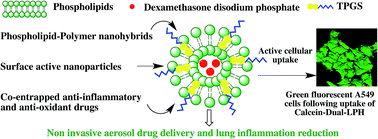Surface-active drug loaded lipopolymeric nanohybrid aerosol therapy: potential non-invasive way to mitigate lipopolysaccharide mediated inflammation in murine lungs†
Abstract
In the present study, surface-active lipopolymeric nanohybrids (LPH) measuring 200–300 nm were developed and evaluated for their efficacy as non-invasive aerosol therapy to reduce lung inflammation and lung injury in rats caused by 5 mg per kg body weight intratracheally administered lipopolysaccharide (LPS). The nanoparticles comprised of phospholipids DPPC and POPG along with polymeric anti-oxidant D-α-tocopheryl polyethylene glycol 1000 succinate (TPGS) or dexamethasone disodium phosphate (DXP) or both. The formulation closely mimics surface tension modulation properties like innate pulmonary surfactant (PS). The dual drug LPH (Dual-LPH) aerosol therapy provided maximum beneficial effect compared to individual drug loaded nanoparticle aerosol treatment. Chest X-rays and lung tissue histopathological studies revealed that Dual-LPH aerosol therapy at a dose of 200 mg phospholipid + 50 mg TPGS + 2 mg DXP per kg body weight significantly reduced inflammation, damage to the alveolar network and pulmonary hemorrhage in LPS injured rats. Significant reduction in levels of neutrophils, total protein, oxidative stress and inflammatory cytokines like TNF-α, IL-1β and IL-6 in bronchoalveolar lavage fluid (BALF) was seen in the Dual-LPH treated group. BALF capillary patency studies revealed rise in capillary patency from 0% for LPS injured group to 99.7 ± 0.1% for Dual-LPH treated group, which is comparable to that of innate surfactant in healthy conditions, indicating that Dual-LPH treatment helped in opening occluded airways. Surface-active TPGS helped in scavenging the free radicals in the injured lungs whereas DXP helped in modulating the inflammation pathway. This multipronged approach can thus serve as a potential non-invasive treatment modality for reducing lung inflammation in lung injury cases.


 Please wait while we load your content...
Please wait while we load your content...